Flow-Induced Vibration of Non-Rotating Structures of a High-Head Pump-Turbine during Start-Up in Turbine Mode
Abstract
:1. Introduction
2. Methodology of FSI Calculation
2.1. Governing Equations of 1-D Pipeline Calculation
2.2. Governing Equations of 3-D FSI Calculation
3. Set-Up of Flow-Induced Vibration Calculation
3.1. Transient Calculation of 1-D Pipeline
3.2. Setup of the 3-D CFD Numerical Simulation
3.3. Results of the 3-D CFD Numerical Simulation
4. Flow-Induced Vibration Analysis of Non-Rotating Structures
4.1. Setup of the Flow-Induced Vibration Analysis for Non-Rotating Structures
4.2. Results of the Flow-Induced Vibration Analysis for Non-Rotating Structures
5. Conclusions
Author Contributions
Funding
Data Availability Statement
Acknowledgments
Conflicts of Interest
Abbreviations
| RSI | Rotor–Stator Interaction |
| CFD | Computational Fluid Dynamics |
| FSI | Fluid-Structure Interaction |
| GVO | Guide Vane Opening |
| FEA | Finite Element Analysis |
References
- Zhao, W.; Presas, A.; Egusquiza, M.; Valentín, D.; Egusquiza, E.; Valero, C. On the use of Vibrational Hill Charts for improved condition monitoring and diagnosis of hydraulic turbines. Struct. Health Monit. 2022, 21, 14759217211072409. [Google Scholar] [CrossRef]
- Zhao, W.; Presas, A.; Egusquiza, M.; Valentín, D.; Egusquiza, E.; Valero, C. Increasing the operating range and energy production in Francis turbines by an early detection of the overload instability. Measurement 2021, 181, 109580. [Google Scholar] [CrossRef]
- Wang, H.; Jiang, H. Design of the control sequence for monitoring and control system of Pushihe Pumped Storage Power Station. In Proceedings of the 2012 IEEE International Conference on Computer Science and Automation Engineering (CSAE), Zhangjiajie, China, 25–27 May 2012; Volume 1, pp. 329–331. [Google Scholar]
- Ansari, B.; Aligholami, M.; Rostamzadeh Khosroshahi, A. An experimental and numerical investigation into using hydropower plant on oil transmission lines. Energy Sci. Eng. 2022, in press. [Google Scholar] [CrossRef]
- Zhao, W.; Egusquiza Estévez, E.; Valero Ferrando, M.D.C.; Egusquiza Montagut, M.; Valentín Ruiz, D.; Presas Batlló, A. A novel condition monitoring methodology based on neural network of pump-turbines with extended operating range. In Proceedings of the 16th IMEKO TC10 Conference on Testing, Diagnostics & Inspection as a Comprehensive Value Chain for Quality & Safety, Berlin, Germany, 3–4 September 2019; pp. 154–159. [Google Scholar]
- Zhang, Y.; Zheng, X.; Li, J.; Du, X. Experimental study on the vibrational performance and its physical origins of a prototype reversible pump turbine in the pumped hydro energy storage power station. Renew. Energy 2019, 130, 667–676. [Google Scholar] [CrossRef]
- Egusquiza, E.; Valero, C.; Valentin, D.; Presas, A.; Rodriguez, C.G. Condition monitoring of pump-turbines. New challenges. Measurement 2015, 67, 151–163. [Google Scholar] [CrossRef] [Green Version]
- Rodriguez, C.G.; Mateos-Prieto, B.; Egusquiza, E. Monitoring of rotor-stator interaction in pump-turbine using vibrations measured with on-board sensors rotating with shaft. Shock Vib. 2014, 2014, 276796. [Google Scholar] [CrossRef] [Green Version]
- Kaneko, Y.; Iwasaki, Y. Study on Vibration Response of High Head Pump Turbine Runner (Vibration Characteristics of Mistuned Runner). J. Environ. Eng. 2008, 3, 37–48. [Google Scholar] [CrossRef] [Green Version]
- Liang, Q.; Rodríguez, C.; Egusquiza, E.; Escaler, X.; Avellan, F. Modal response of hydraulic turbine runners. In Proceedings of the 23rd IAHR Symposium on Hydraulic Machinery and Systems, Yokohama, Japan, 17–21 October 2006; Volume 1, pp. 1–9. [Google Scholar]
- Valentín, D.; Presas, A.; Egusquiza, E.; Valero, C.; Bossio, M. Dynamic response of the MICA runner. Experiment and simulation. In Proceedings of the Journal of Physics: Conference Series; IOP Publishing: Bristol, UK, 2017; Volume 813, p. 012036. [Google Scholar]
- Valentín, D.; Presas, A.; Egusquiza, M.; Valero, C.; Egusquiza, E. Behavior of Francis turbines at part load. Field assessment in prototype: Effects on power swing. In Proceedings of the IOP Conference Series: Earth and Environmental Science; IOP Publishing: Bristol, UK, 2019; Volume 240, p. 062012. [Google Scholar]
- Egusquiza, E.; Valero, C.; Presas, A.; Huang, X.; Guardo, A.; Seidel, U. Analysis of the dynamic response of pump-turbine impellers. Influence of the rotor. Mech. Syst. Signal Process. 2016, 68, 330–341. [Google Scholar] [CrossRef]
- He, Q.; Huang, X.; Yang, M.; Yang, H.; Bi, H.; Wang, Z. Fluid–Structure Coupling Analysis of the Stationary Structures of a Prototype Pump Turbine during Load Rejection. Energies 2022, 15, 3764. [Google Scholar] [CrossRef]
- Kolšek, T.; Duhovnik, J.; Bergant, A. Simulation of unsteady flow and runner rotation during shut-down of an axial water turbine. J. Hydraul. Res. 2006, 44, 129–137. [Google Scholar] [CrossRef]
- Song, X.; Luo, Y.; Wang, Z. Numerical prediction of the influence of free surface vortex air-entrainment on pump unit performance. Ocean. Eng. 2022, 256, 111503. [Google Scholar] [CrossRef]
- Wang, W.; Wang, X.; Wang, Z.; Ni, M.; Yang, C. Analysis of Internal Flow Characteristics of a Startup Pump Turbine at the Lowest Head under No-Load Conditions. J. Mar. Sci. Eng. 2021, 9, 1360. [Google Scholar] [CrossRef]
- He, L.; Wang, Z.; Kurosawa, S.; Nakahara, Y. Resonance investigation of pump-turbine during startup process. In Proceedings of the IOP Conference Series: Earth and Environmental Science; IOP Publishing: Bristol, UK, 2014; Volume 22, p. 032024. [Google Scholar]
- Mao, Z.; Tao, R.; Chen, F.; Bi, H.; Cao, J.; Luo, Y.; Fan, H.; Wang, Z. Investigation of the starting-up axial hydraulic force and structure characteristics of pump turbine in pump mode. J. Mar. Sci. Eng. 2021, 9, 158. [Google Scholar] [CrossRef]
- Chen, F.; Bi, H.; Ahn, S.H.; Mao, Z.; Luo, Y.; Wang, Z. Investigation on dynamic stresses of pump-turbine runner during start up in turbine mode. Processes 2021, 9, 499. [Google Scholar] [CrossRef]
- Casanova, F.; Mantilla, C. Fatigue failure of the bolts connecting a Francis turbine with the shaft. Eng. Fail. Anal. 2018, 90, 1–13. [Google Scholar] [CrossRef]
- Wang, Z.; Yang, J.; Wang, W.; Qu, J.; Huang, X.; Zhao, W. Research on the Flow-Induced Stress Characteristics of Head-Cover Bolts of a Pump-Turbine during Turbine Start-Up. Energies 2022, 15, 1832. [Google Scholar] [CrossRef]
- Chen, F.; Chen, L.; Wang, Z.; Yu, J.; Luo, C.; Zhao, Z.; Ren, S.; Li, J.; Deng, D. Computation of static stresses of the head cover bolts in a pump turbine. In Proceedings of the IOP Conference Series: Materials Science and Engineering; IOP Publishing: Bristol, UK, 2019; Volume 493, p. 012143. [Google Scholar]
- Bi, H.; Chen, F.; Wang, C.; Wang, Z.; Fan, H.; Luo, Y. Analysis of dynamic performance in a pump-turbine during the successive load rejection. In Proceedings of the IOP Conference Series: Earth and Environmental Science; IOP Publishing: Bristol, UK, 2021; Volume 774, p. 012152. [Google Scholar]
- Li, X.; Mao, Z.; Lin, W.; Bi, H.; Tao, R.; Wang, Z. Prediction and analysis of the axial force of pump-turbine during load-rejection process. In Proceedings of the IOP Conference Series: Earth and Environmental Science; IOP Publishing: Bristol, UK, 2020; Volume 440, p. 052081. [Google Scholar]
- Nicolle, J.; Giroux, A.; Morissette, J. CFD configurations for hydraulic turbine startup. In Proceedings of the IOP Conference Series: Earth and Environmental Science; IOP Publishing: Bristol, UK, 2014; Volume 22, p. 032021. [Google Scholar]

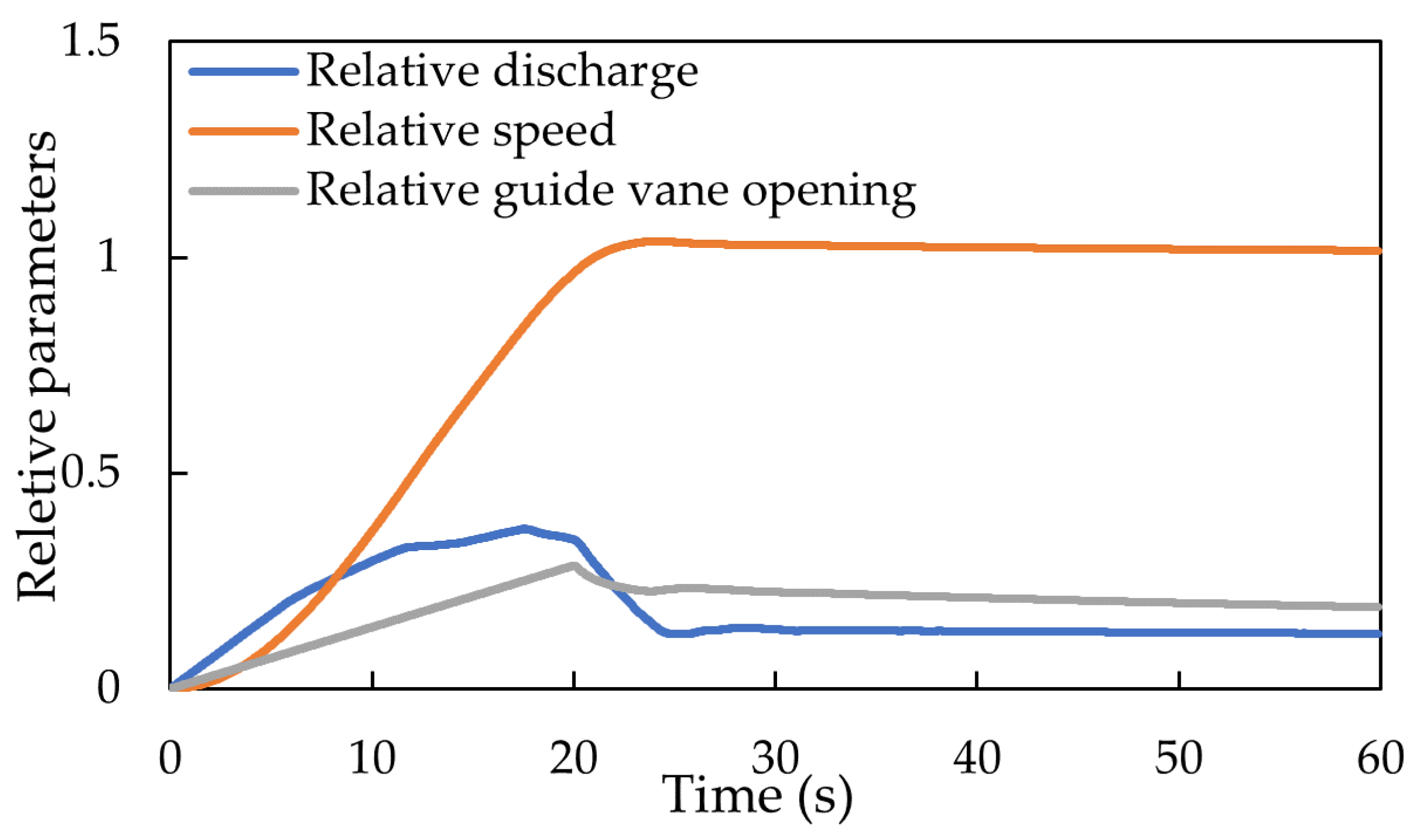


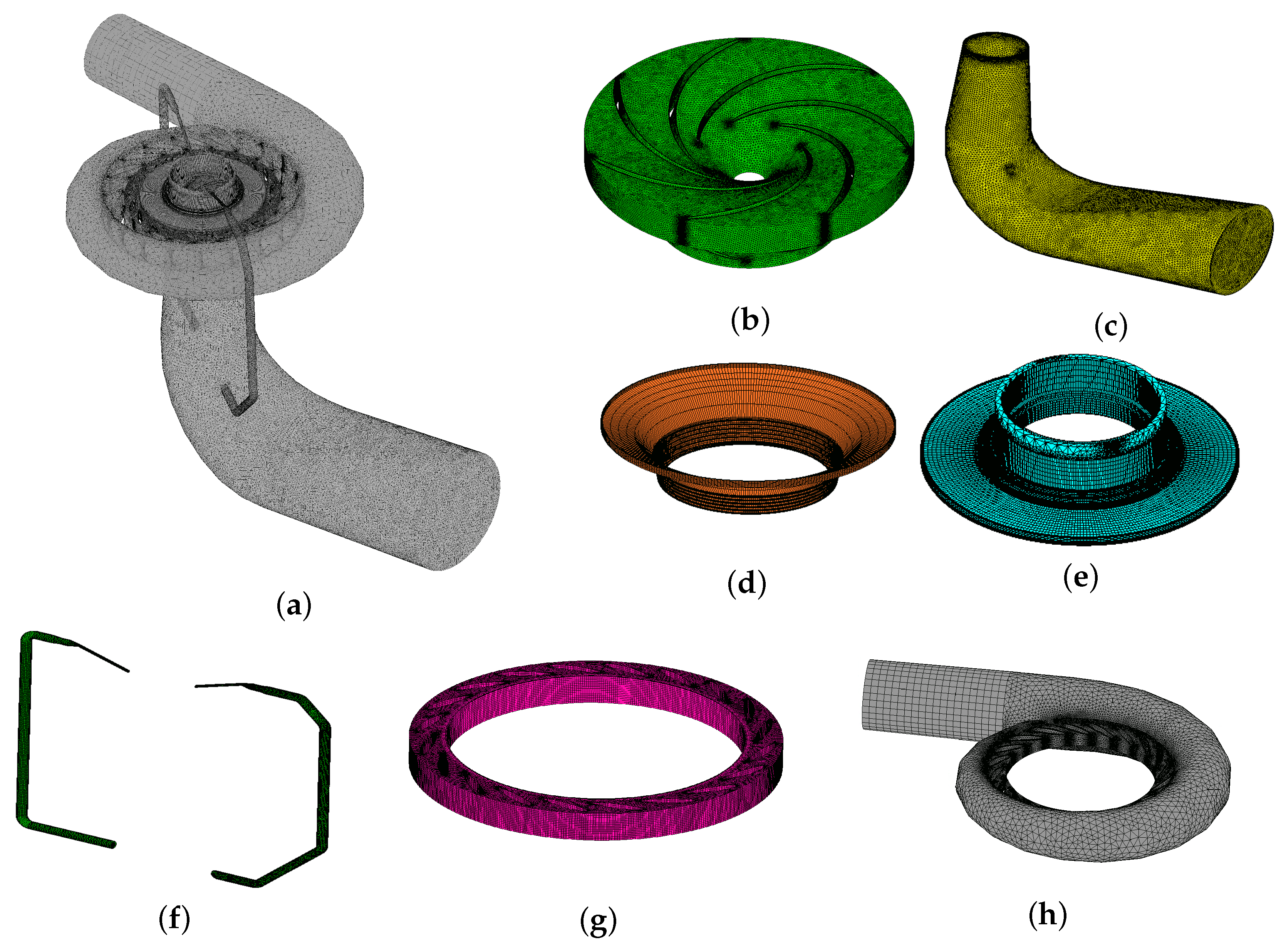

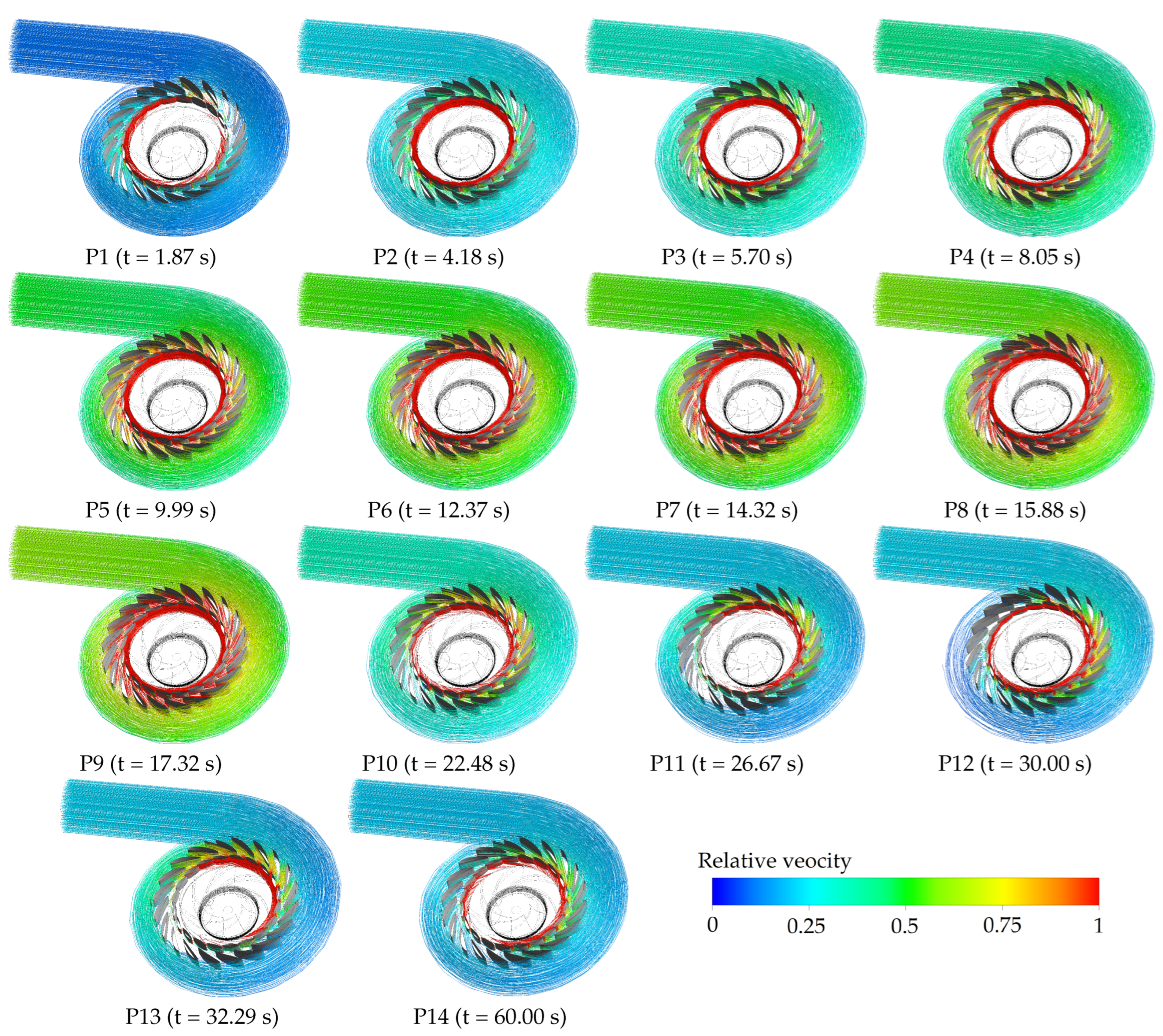
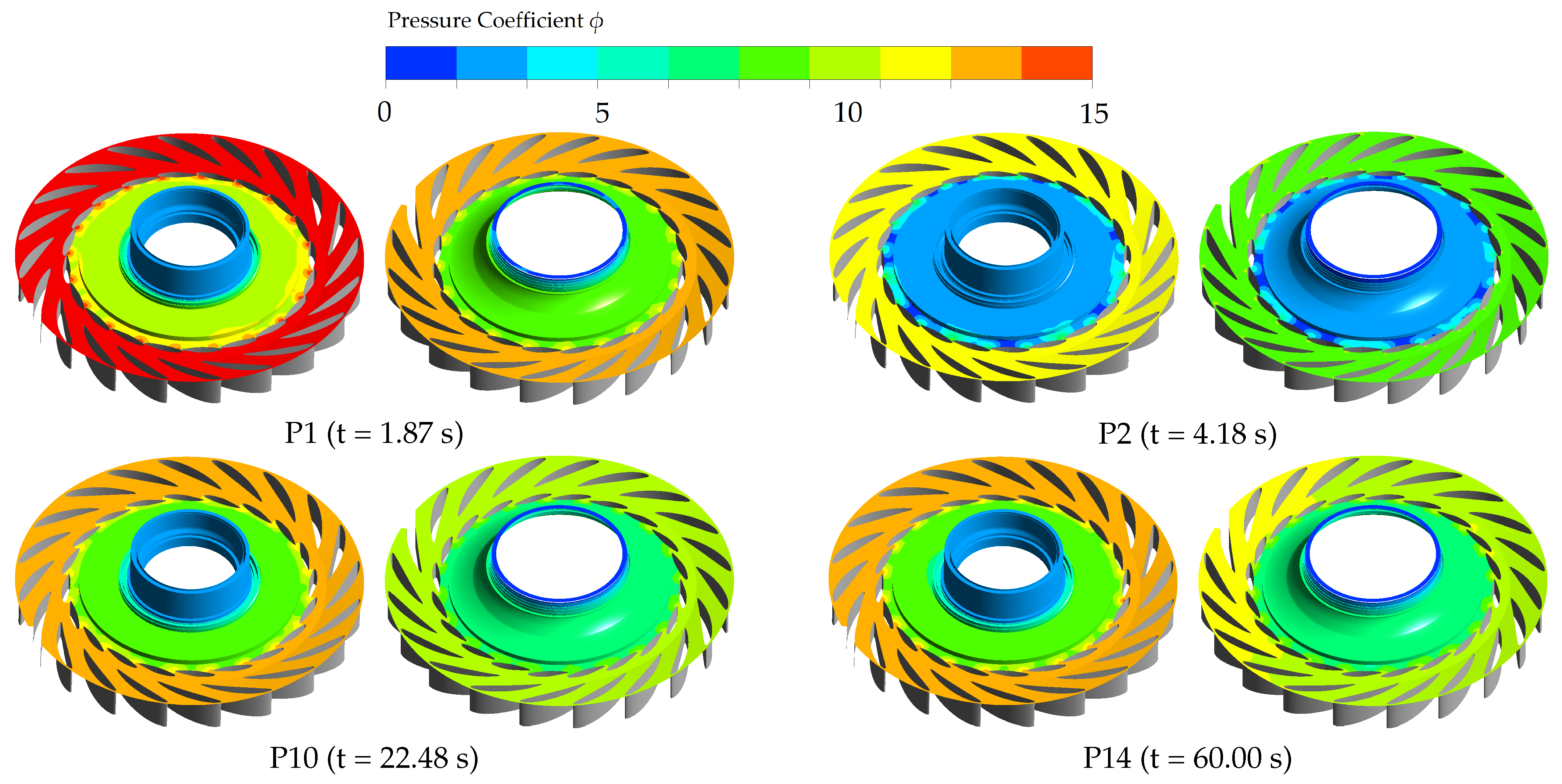
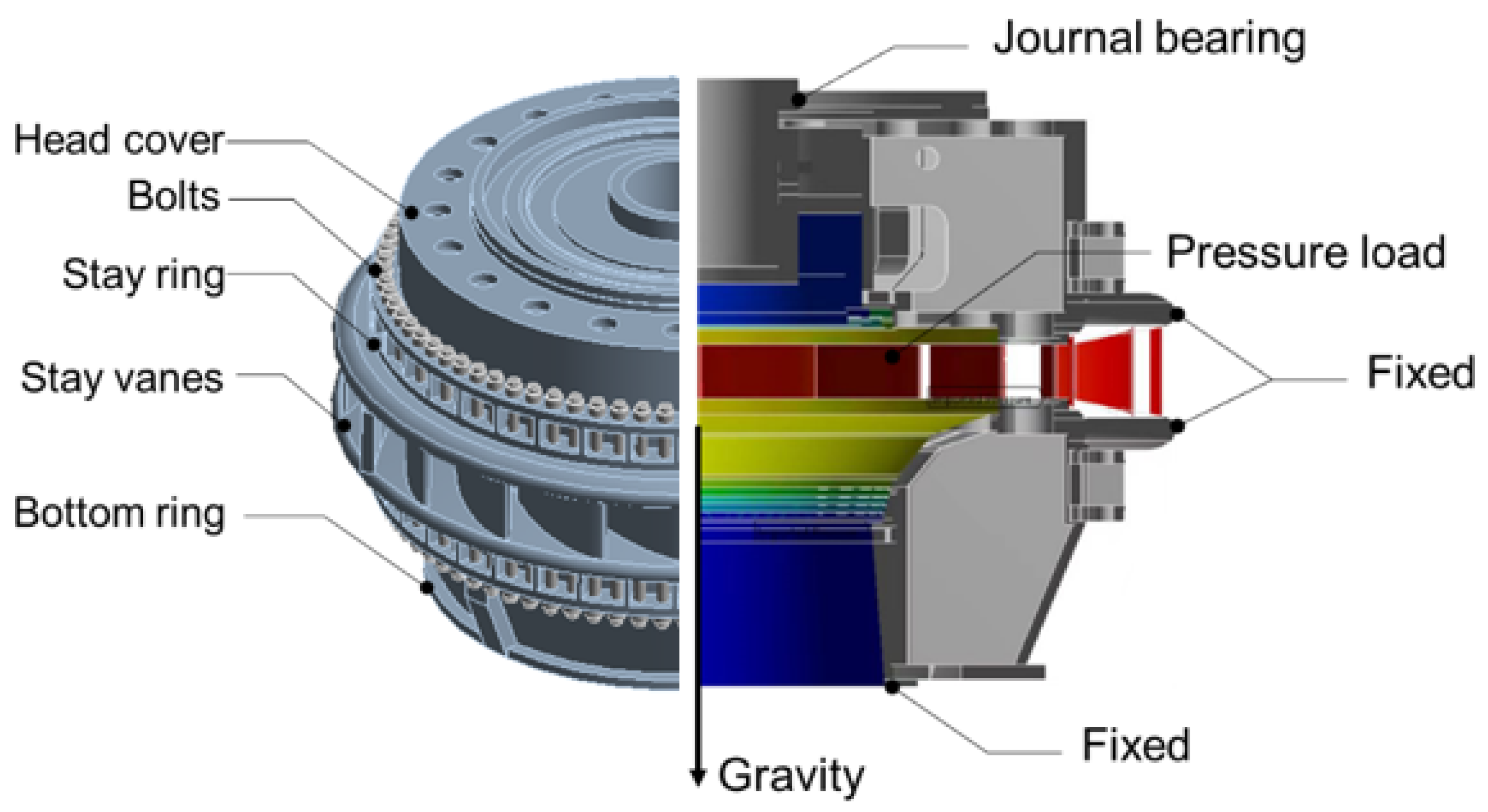
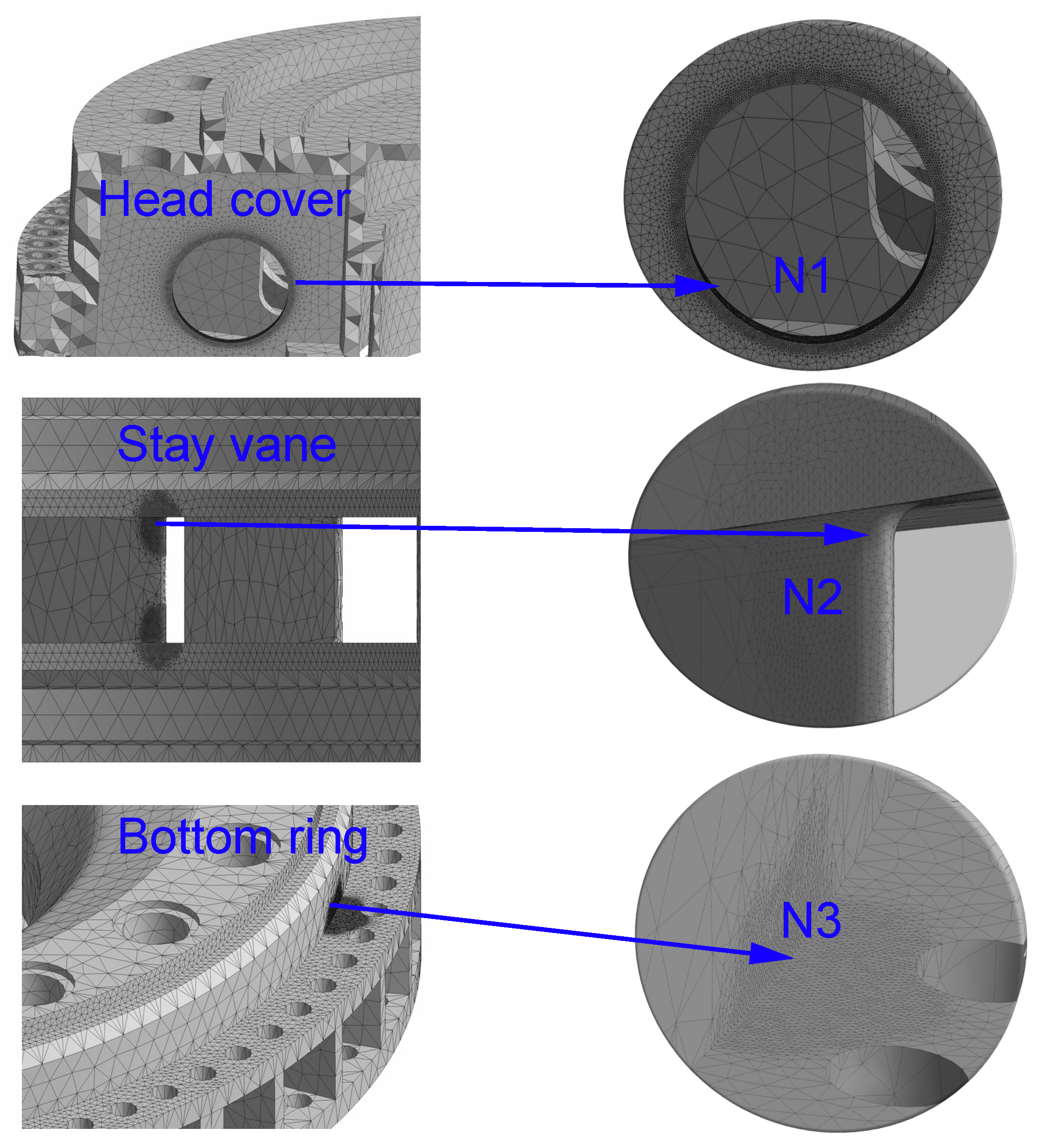


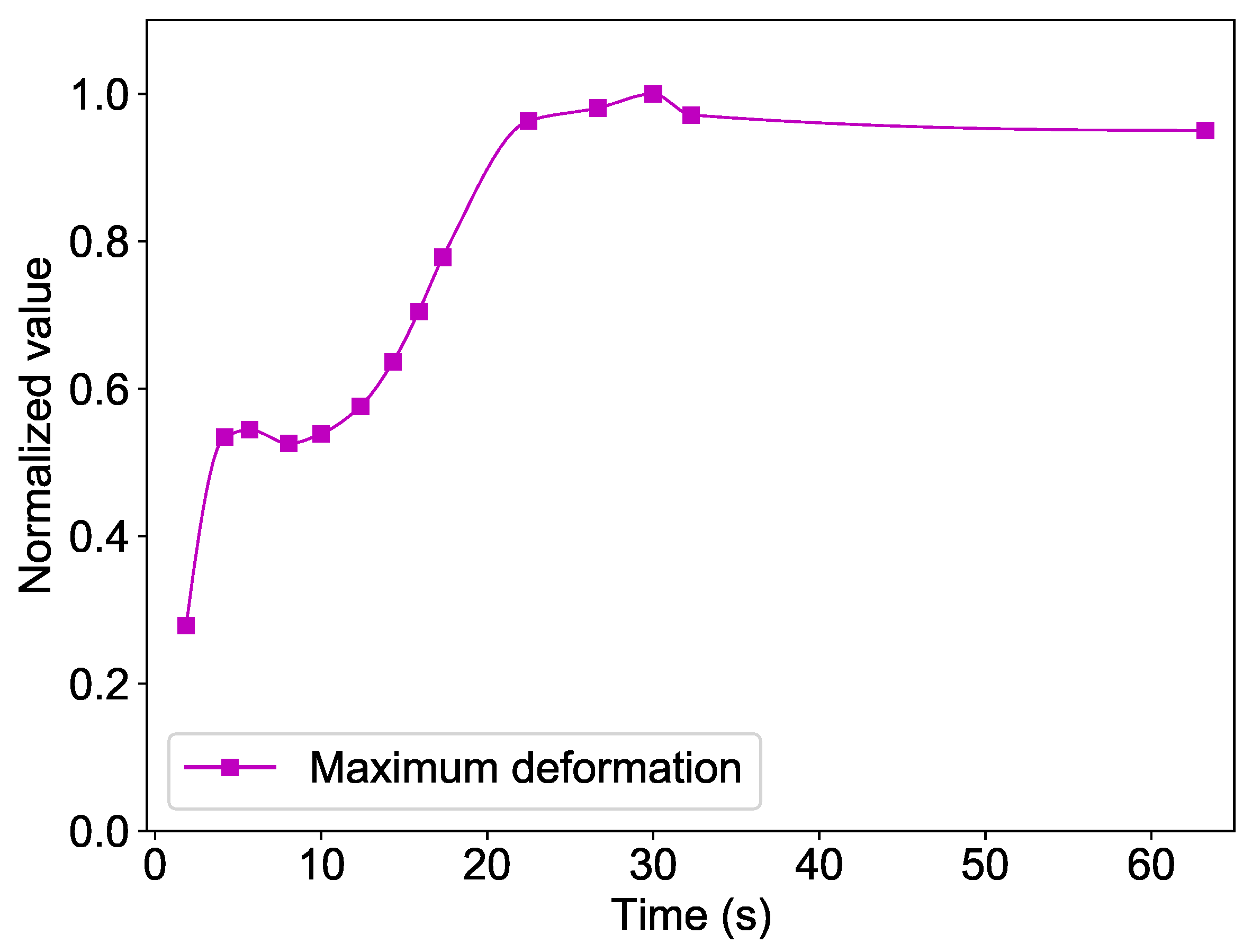

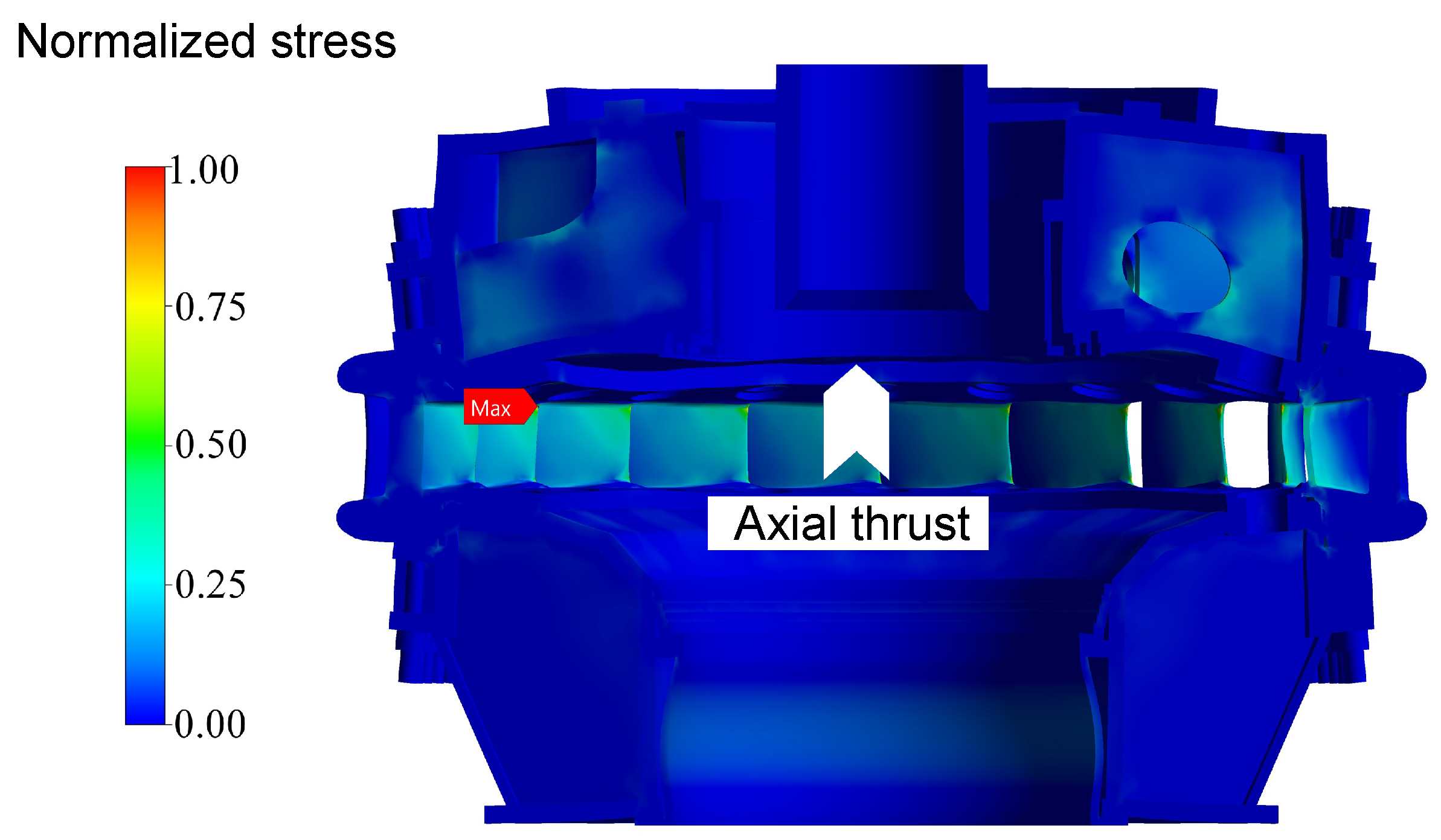
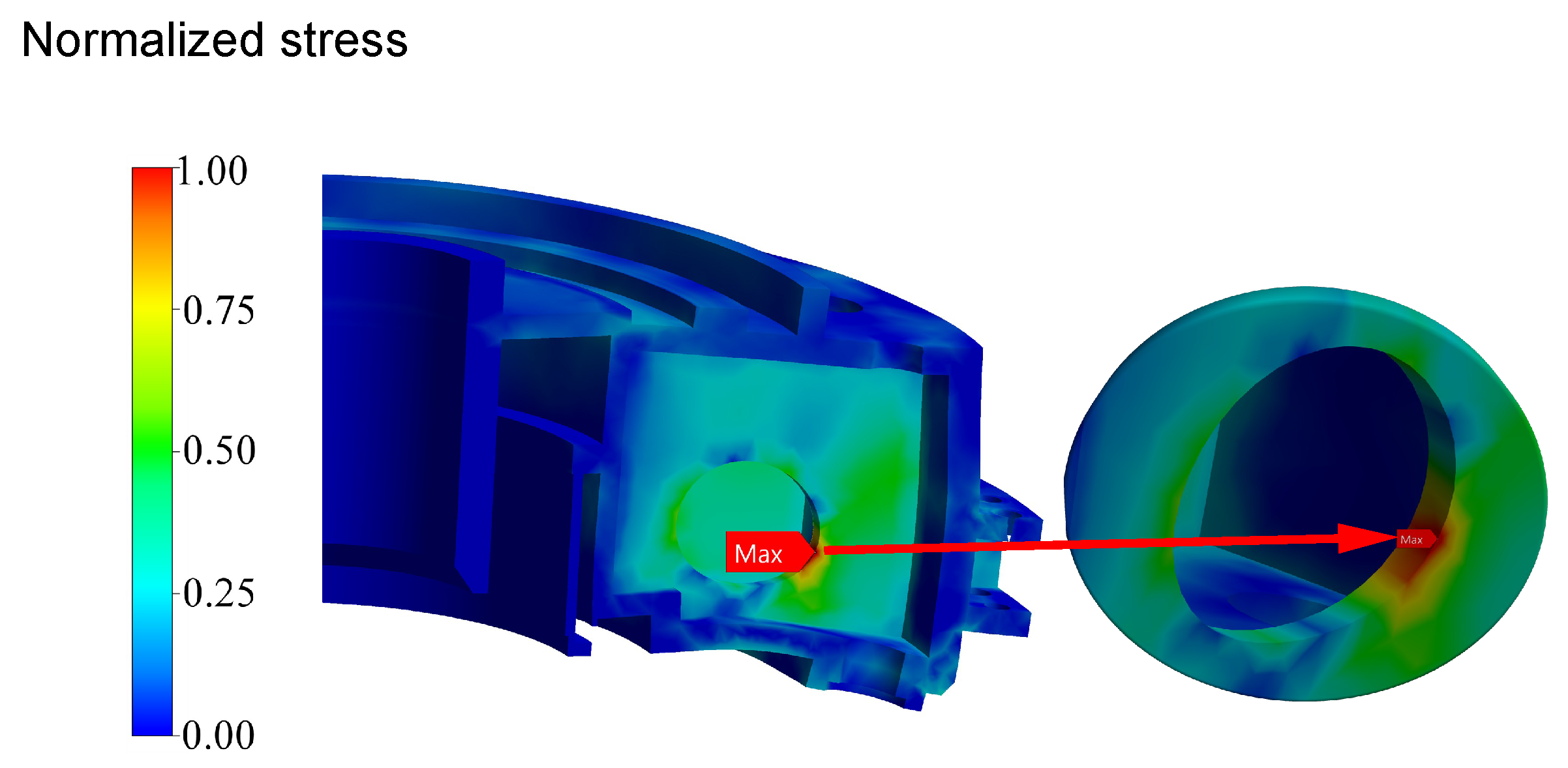
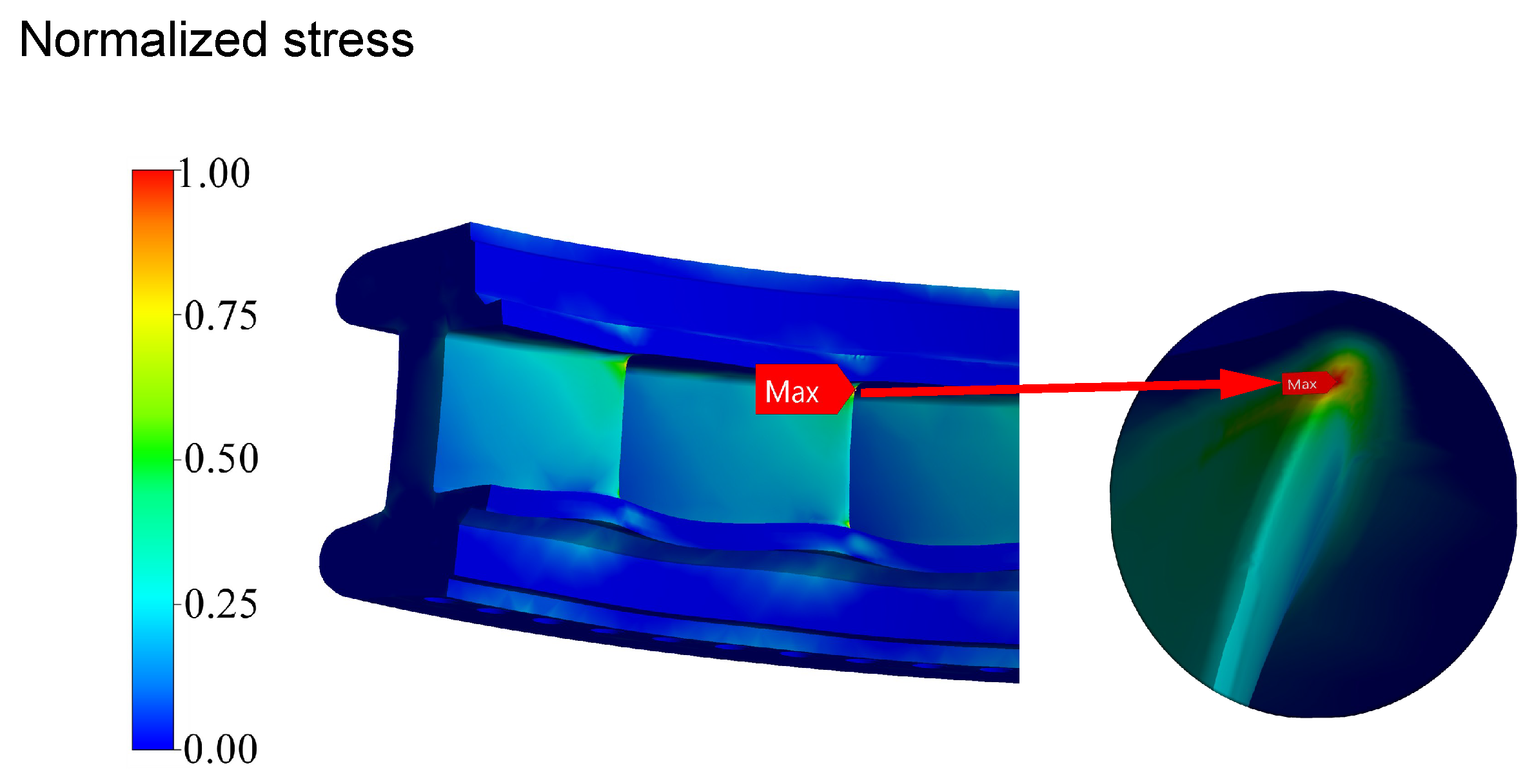

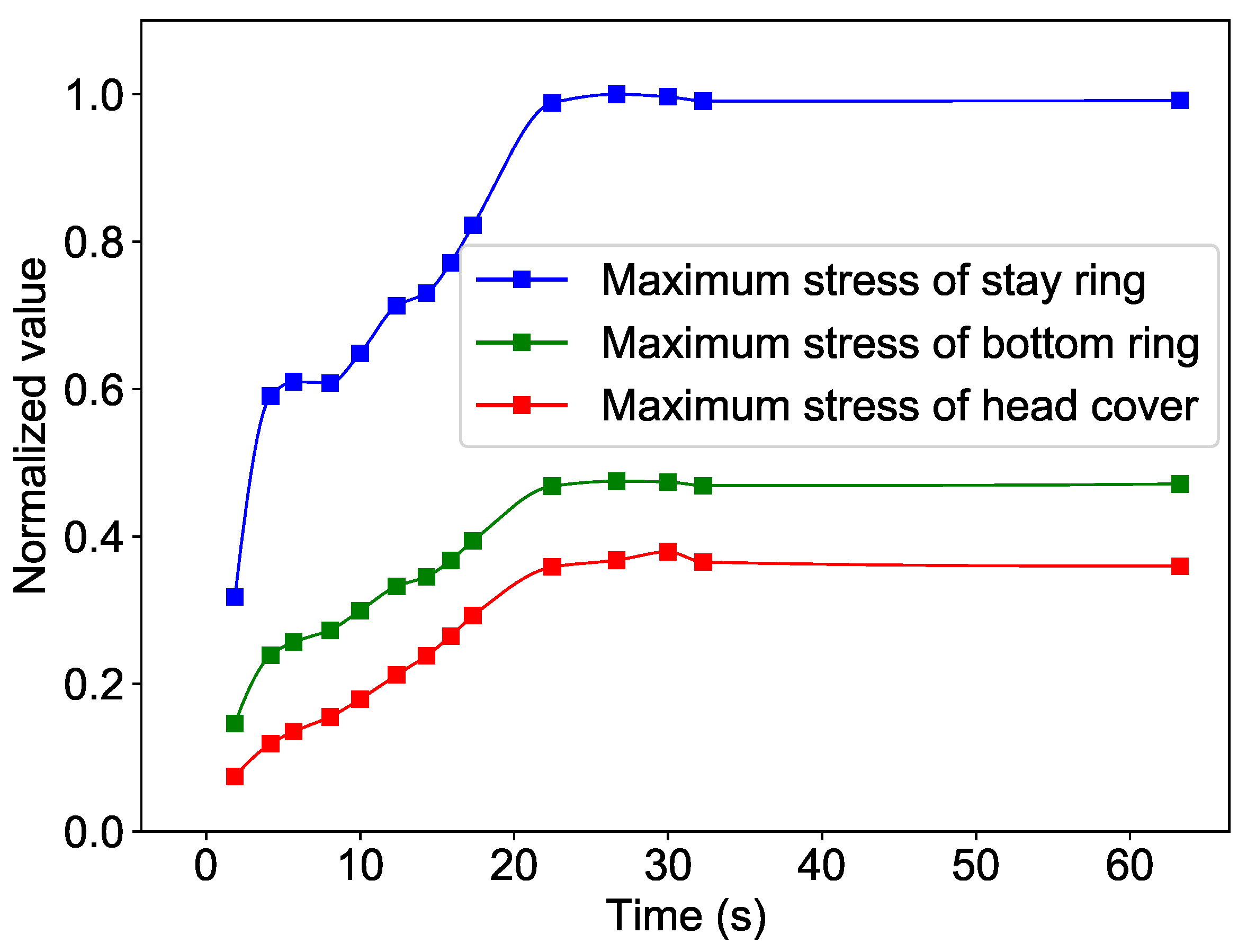

| Fluid Domain | Mesh 1 (×) | Mesh 2 (×) | Mesh 3 (×) | Mesh 4 (×) |
|---|---|---|---|---|
| Runner | 2.94 | 3.27 | 3.63 | 4.25 |
| Guide vane | 0.22 | 0.24 | 0.27 | 0.32 |
| Spiral casing and stay vane | 2.64 | 2.93 | 3.26 | 3.81 |
| Draft tube | 0.49 | 0.54 | 0.60 | 0.70 |
| Labyrinth seals and pressure balance pipes | 0.32 | 0.36 | 0.40 | 0.47 |
| Total model | 6.61 | 7.34 | 8.16 | 9.55 |
Publisher’s Note: MDPI stays neutral with regard to jurisdictional claims in published maps and institutional affiliations. |
© 2022 by the authors. Licensee MDPI, Basel, Switzerland. This article is an open access article distributed under the terms and conditions of the Creative Commons Attribution (CC BY) license (https://creativecommons.org/licenses/by/4.0/).
Share and Cite
Yang, M.; Zhao, W.; Bi, H.; Yang, H.; He, Q.; Huang, X.; Wang, Z. Flow-Induced Vibration of Non-Rotating Structures of a High-Head Pump-Turbine during Start-Up in Turbine Mode. Energies 2022, 15, 8743. https://doi.org/10.3390/en15228743
Yang M, Zhao W, Bi H, Yang H, He Q, Huang X, Wang Z. Flow-Induced Vibration of Non-Rotating Structures of a High-Head Pump-Turbine during Start-Up in Turbine Mode. Energies. 2022; 15(22):8743. https://doi.org/10.3390/en15228743
Chicago/Turabian StyleYang, Mengqi, Weiqiang Zhao, Huili Bi, Haixia Yang, Qilian He, Xingxing Huang, and Zhengwei Wang. 2022. "Flow-Induced Vibration of Non-Rotating Structures of a High-Head Pump-Turbine during Start-Up in Turbine Mode" Energies 15, no. 22: 8743. https://doi.org/10.3390/en15228743







